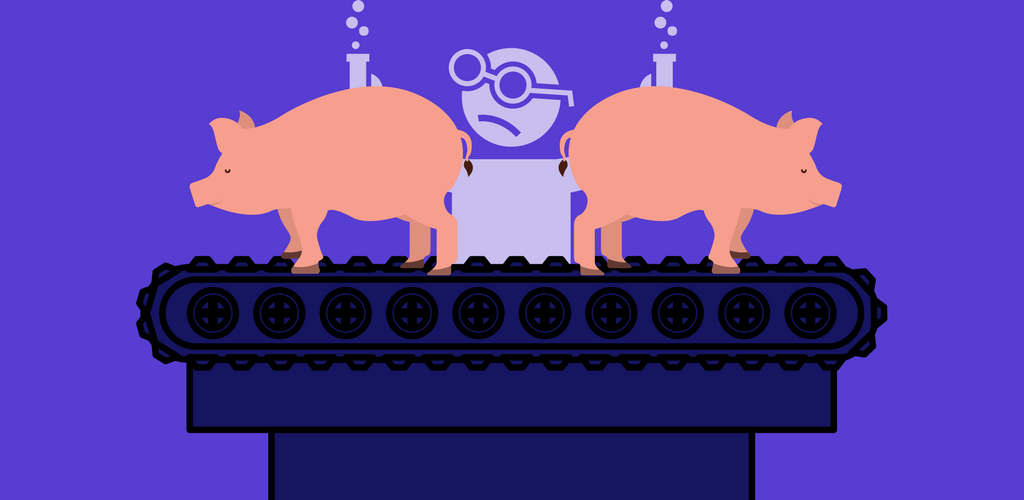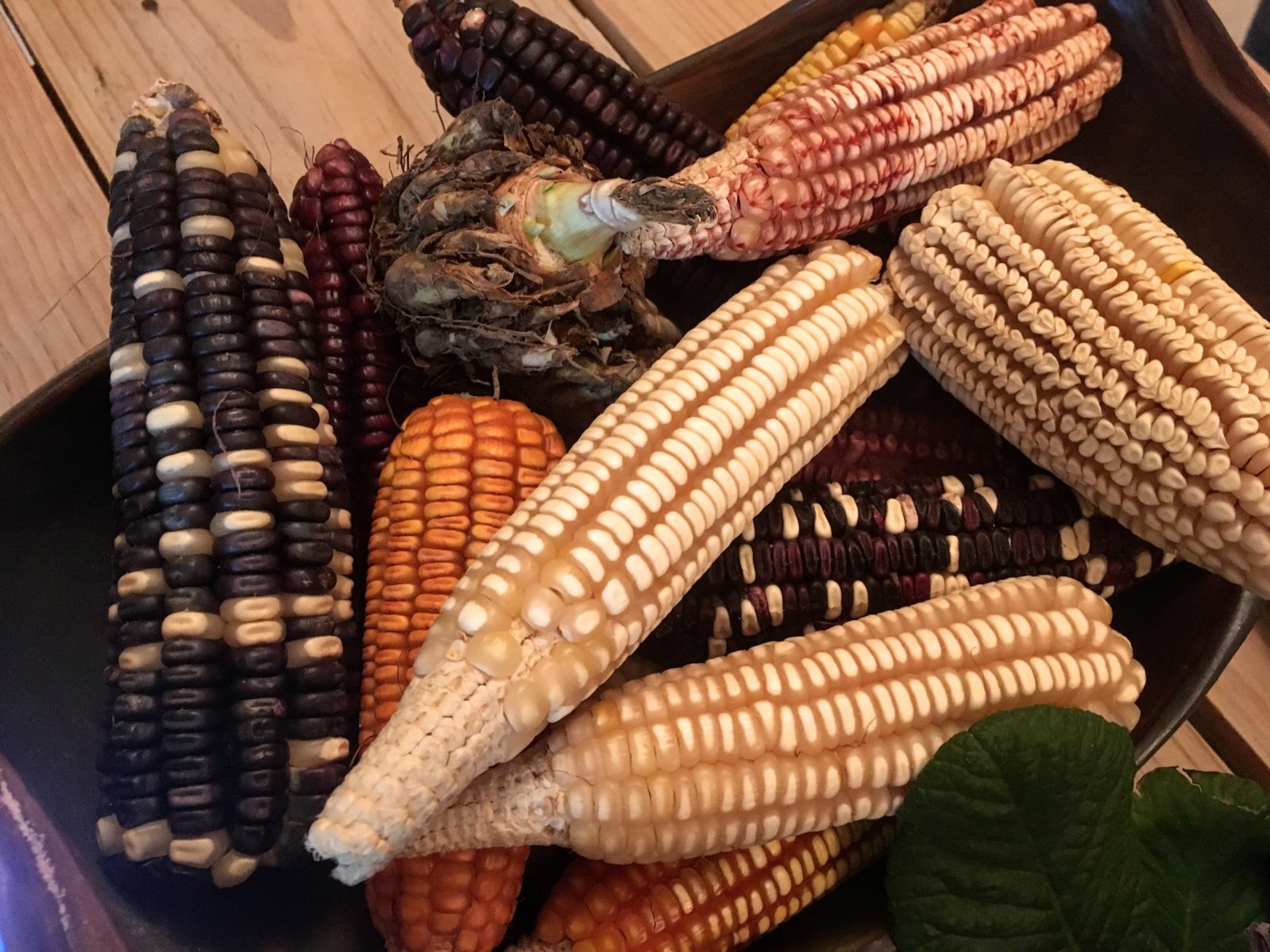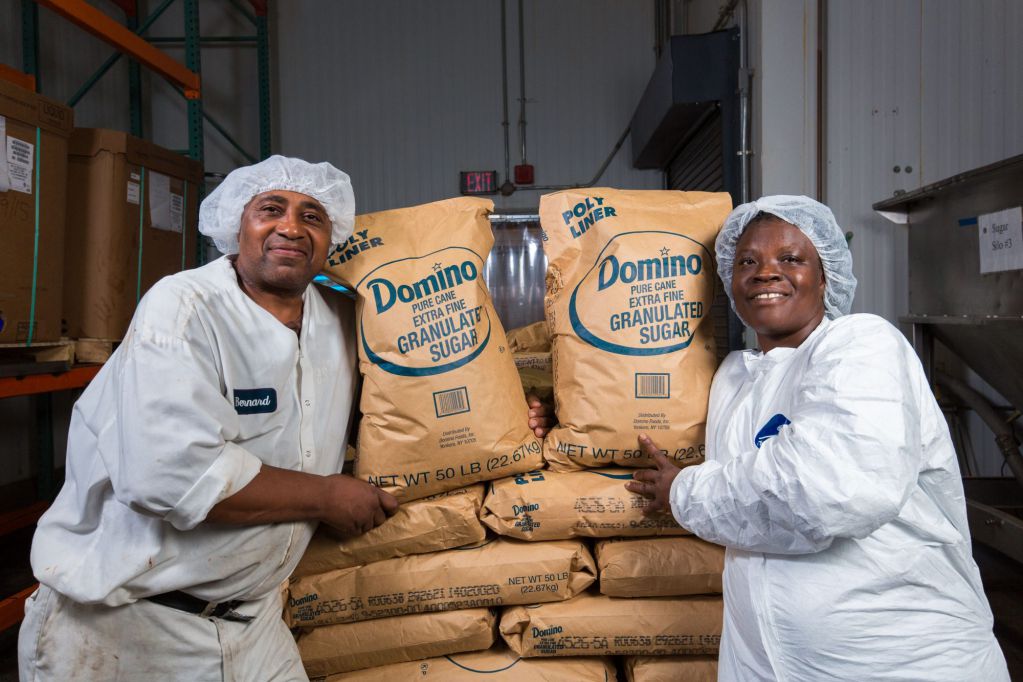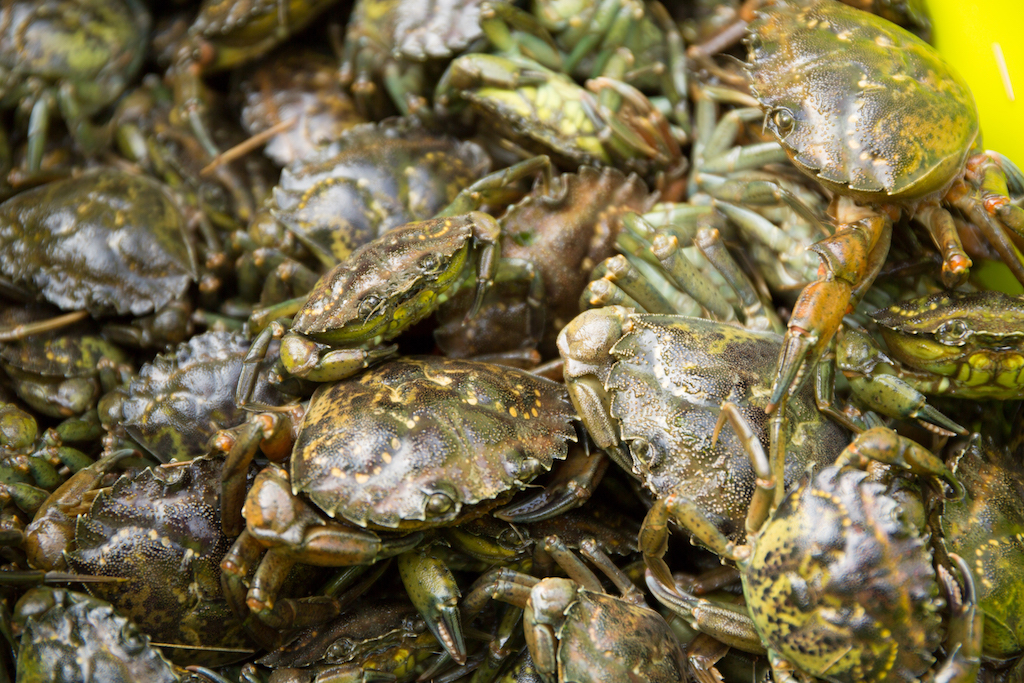
NFE
This piece has been updated.
You’ve probably heard the news that genetically engineered (GE) Atlantic salmon is on the way.
A fish that grows at twice the speed of conventionally raised salmon with 20 percent less feed, and without the vaccinations sometimes needed to treat wild-caught salmon, could be a silver bullet for the seafood industry.
And with the recent announcement that AquaBounty, the publicly traded company behind this super-salmon, would soon start growing the fish in an Indiana facility, you’d be forgiven for thinking that grocery stores full of other GE animals are just around the corner.
But you’d be wrong. In fact, AquAdvantage is poised to be the first of its kind: An animal genetically engineered for food. Other GE animals have been developed, bred, and tested. But politics and public fears—not to mention a byzantine regulatory system—have kept them off our plates.
 NFE
NFE A primer on the different terms used to describe your food
Here are six other genetically engineered animals that never made it as far downstream as the AquAdvantage salmon:
Mastitis-resistant livestock
The very first genetically modified cow bred for human food was named Annie. She was born in March of 2000 at a United States Department of Agriculture (USDA) research facility in Beltsville, Maryland.
In hopes of developing a way to combat the infection before it even developed, Agriculture Research Service (ARS) lab scientists took a bacterial gene that produced lysostaphin, an antibacterial protein that fights mastitis, and a sheep gene that catalyzed production, and injected the material into a batch of newly fertilized eggs in a lab. After the eggs began dividing into embryos in their dishes, the scientists fertilized them in surrogate mothers. Around a year after Annie was born, scientists rubbed staph on her udders, and those of two other transgenic cows, and mastitis did not develop. Success.
The process of transferring genes from one organism to another is called transgenesis. We have it to thank for crops like Bt sweet corn, the maize variety named for a bacteria gene that acts like a natural pesticide. Monsanto, the seed giant, brought the corn to market in 1995, and we’ve been growing it in this country ever since.
Genetically engineered animals, however, are regulated by FDA as “new animal drugs.” The thinking is straightforward: A drug is anything that affects the structure and function of an organism. That means the genetic material that went into the egg that became Annie is itself considered a kind of drug.
“It’s not very often that you get to say you cured a disease,” Kevin Wells, an ARS geneticist, and one of the project’s lead scientists, later told Harvest Public Media. “But because of the fear of public perception, those animals, no one’s even attempted to take them to market.”
With no eventual market to get to, Annie was euthanized and buried. And maybe, somewhere in a locker in Beltsville, her unborn cousins are still in test tubes or petri dishes, chilling in a freezer. (We couldn’t reach the project’s scientists by press time.)
Enviropig
You’d think, based on what we know about the Flavr Savr tomato, or other Bt crops, that most food is genetically engineered in the name of hardiness, or even to taste better. But other products have been developed in the name of environmental protection.
 Left to right: Flickr / Tambako the Jaguar; Flickr / kagawa_ymg
Left to right: Flickr / Tambako the Jaguar; Flickr / kagawa_ymg The enviropiglet had genetic material, attached to mouse DNA, which produced an enzyme that worked on digesting phosphorus and secreting less of it in his poop
Remember the Enviropig? In 1999, the first pig genetically modified for food was created by scientists at the University of Guelph, outside Toronto. The enviropiglet had genetic material, attached to mouse DNA, which produced an enzyme that worked on digesting phosphorus and secreting less of it in his poop. If this little mouse-pig had gone to market, it would’ve been tremendously attractive to hog farmers trying to minimize pollution, like toxic algal blooms, caused by their runoff.
Researchers applied to both FDA and Health Canada for permits. But in 2012, Ontario Pork, the association of Canadian hog farmers that had been funding the safety testing, dropped its support. None of their pigs had sold. And a competing feed supplement that did the same thing as the enzyme was getting cheaper. Most importantly, neither the Canadian nor American governments had approved the pig for food.
“Food companies,” one of the scientists told Iowa State Daily, “have been slow to back genetically engineered animals without a clear approval process.”
Without funding, The New York Times reported, the university euthanized the 16 Enviropigs in the herd, and froze the transgenic semen. The project’s lead scientist noted that Chinese companies had expressed interest, but no deal was reached. Progress, on ice.
Bird flu-resistant poultry
A few years ago, American poultry farmers were forced to euthanize and dispose of 48 million egg-laying hens infected with bird flu. Never mind the economic hardship. For farmers who’ve spent their professional lives raising and caring for their flocks, the experience can be deeply emotional.
In 2010, Roslin scientists released their findings, along with photos of the transgenic chickens glowing in the dark. (They’d been injected with a protein that distinguished them from the control group.) The lead geneticist on the project told Nature that a chicken farmer would have to spend around $79,000 to integrate the resistant birds into a flock. Excitement was high. And that was it.
Did those photos of nuclear-looking chickens scare interested farmers away? Not exactly. The truth is more benign. As appealing as the idea was in the battle to contain outbreaks, no company thought it a wise enough investment to have to grapple with the American regulatory system.
Poultry production is a vertically integrated business. That means it would’ve been possible for a meat producer like Tyson, for instance, to command its breeders to raise the bird-flu resistant poultry. And indeed, one of its subsidiaries, the Arkansas-based poultry breeder Cobb-Vantress, did support the research. But the company backed out when Tyson decided to halt research into genetically modified chickens more broadly. Tyson’s vice president of R&D, Mitch Abrahamsen, told Reuters that the halt was due, in part, to there being no commercial use for the product. (You’ll hear more from Abrahamsen later.)
 iStock / boschettophotography
iStock / boschettophotography In 2010, Roslin scientists developed a bird flu-resistant chicken, along with photos of the transgenic chickens glowing in the dark
Ultimately, perhaps, Tyson could have taken another tack. Rather than fight a cold war with regulators, why not try to convince the public to see the situation as a matter of animal welfare? It’s hard to imagine animal advocates preferring millions of euthanized birds over a genetically engineered flock that could be spared.
“Society is more accepting of a technology if they can understand the benefit,” Karen Batra, a spokeswoman for the Biotechnology Innovation Organization (BIO), a lobby and trade organization, told The New Food Economy in an email. “If researchers can use gene editing technology to prevent animal diseases—such as avian influenza that potentially can kill millions of birds—people want to alleviate animal suffering.”
“Healthy” pigs
Disease-resistant and environmentally friendly animals are, arguably, developed for the benefit of producers. The traits introduced to pigs and chickens are often there to make breeding more efficient.
But beginning in the late 1980s, scientists were also experimenting with animals for the benefit of eaters, too. In 1994, USDA scientists released the findings from an experiment on 26 transgenic pigs who’d been spliced with a bovine growth hormone gene. It was possible, the scientists concluded, to create “ultra-low fat” pork products that way.
By 2004, scientists weren’t focusing on eliminating fatty acids—just transforming them into better ones. Researchers at the University of Missouri, University of Pittsburgh, and Massachusetts General Hospital used cell cloning to produce six piglets with a protein that converted omega-6 fatty acids into omega-3s, the so-called good fat found in fish. Could scientists use their skills to make food more attractive to eaters? Like, say, bacon that’s good for you?
Theoretically, yes. Omega-3s rose to prominence in the ‘80s, when epidemiologists discovered low rates of heart disease, perhaps due to fish-heavy diets, among Eskimo and Japanese people. Within twenty years, the scales had tipped in the other direction, as consumers were cautioned to limit salmon and tuna consumption because of potentially high levels of mercury in fish. But the grip on the public never wavered. In the form of fish oil supplements, omega-3s could aid ADHD, postpartum depression, and everything in between.
The scientists created a transgenic pig by finding, in a nematode worm, an enzyme that converted fatty acids, and transferring it to the swine. Twelve piglets were born, and five died, due either to complications with birth or to heart defects that are common in cloned pigs. (The notion that molecular scientists create pigs to wantonly inflict pain on them endures.) Among those that survived, most showed the ability to transform omega-6s to omega-3s.
But the worm-pig hasn’t inched any closer to market since. After the scientists published the results of their experiment, no pork producer looked into licensing the intellectual property or developing the pig for market. That’s because, as a “new animal drug,” any farm with a genetically engineered omega-3 pig would have to be regulated like a pharmaceutical plant.
 Left to right: Flickr / Mark Dumont; Flickr / Peter Burka
Left to right: Flickr / Mark Dumont; Flickr / Peter Burka The scientists created a transgenic pig by finding, in a nematode worm, an enzyme that converted fatty acids, and transferring it to the swine
That potential regulation is an obvious non-starter for pig farmers. Try to imagine a pigpen being held to the standards of a cool, clean, and efficient drug plant. It’s an impossible image. In the era of transgenesis, that’s a fight that pork producers didn’t think they could win.
PRRS-resistant pig
But that was then. Now, molecular scientists are doing less gene splicing and more direct editing.
Instead of transferring a foreign gene, as in transgenesis, today’s molecular scientists use gene editing tools, like CRISPR and TALEN, to find specific sites in an animal genome, and edit the material to their specifications. Industry insiders, like Dr. Adrianne Massey, a former North Carolina State University biologist who now works for BIO, are at pains to distinguish gene editing from transgenesis.
“You’re not moving in unknown genes or known genes into the animal,” Massey explained to a roomful of farmers, scientists, and biotech professionals at the National Farmers Union Convention in March. “You’re looking at the existing genes, and you’re saying, ‘I’m changing that one right there, this is the way I’m gonna change it.’ Because you’re changing an existing gene, and not moving in foreign genetic material, it’s a form of mutagenesis.” In Massey’s mind, gene editing is like traditional breeding, which emphasizes specific traits.
For the past couple of years, Lightner’s company has been developing PRRS-resistant pigs, having licensed intellectual property developed at the University of Missouri. That technology involves making a cell deletion, and changing the shape of a protein so the virus can’t bind to it.
To do that, Genus uses CRISPR to edit pig embryos from lines of “elite” boars and young female—pigs that the company has bred using natural, conventional methods for more than 50 years, to be as healthy and vigorous and full of pork as possible. (“Optimized,” Lightner calls them.) Genus is currently in the process of breeding the first generation of what could be four generations of the PRRS pigs. All of them will live on a Genus farm in Adolphus, Kentucky, where they’ll breed for generations and never enter the food chain.
In a statement released in February, the National Pork Producers Council called for moving regulatory oversight of the animals from FDA to a department of USDA that already regulates gene editing in plants. Gene editing, the council asserts, is totally different from transgenesis. By treating the processes as one and the same, the government is stifling innovation.
Hornless holsteins
Part of the strategy behind garnering public support for gene-edited animals is to try to get consumers, and the regulatory agencies that work on their behalf, past any freaky images that may once have been conjured by transgenesis. Forget the unnatural merging of animal genes in a lab. Today’s scientists are just doing the work of natural selection, but faster.
That’s one of the arguments that Recombinetics, a gene editing company based in St. Paul, Minnesota, is making, in order to promote a proof of concept it has for hornless Holstein dairy cows. The horns on dairy cows are huge, and can be dangerous—both for the other animals in the herd, and their human handlers. When they’re mechanically removed from young dairy cows, the process can be costly for the farmer and painful for the animal.
 Left-to-right: Flickr / Korona Lacasse; Flickr / Pimthida
Left-to-right: Flickr / Korona Lacasse; Flickr / Pimthida Scientists harvest pre-fertilized eggs from a top-of-the-line herd of crossbred animals, and edit the genes so that they no longer produce horns
Hornless mutations occur naturally in some beef cattle breeds, like the Angus cow. Historically, a farmer who wanted hornless Holsteins would have had to cross-breed. To get that gene into a cow herd could take a lifetime, with nine-month gestation periods and years before offspring can reproduce. Recombinetics wants to get there by “turning off” the gene that provides for horns.
To do that, scientists harvest oocytes, or pre-fertilized eggs, from the company’s top-of-the-line herd of crossbred animals, and edit the genes so that they no longer produce horns. Those oocytes are inserted into hundreds of surrogate cells as part of an in-vitro fertilization process, and then carried by the animal to term. The goal is to take semen from the hornless bulls and introduce them to dairy herds all over the world.
Nevertheless, the hornless Holstein is regulated the same way as a worm-swine or eel-salmon or cow-pig, much to the industry’s consternation.
“We’re as far away from transgenic as you can get,” says Mitch Abrahamsen, the former Tyson scientist who’s now the executive vice president of Recombinetics. “We are just modifying the version of the gene that already exists to a different version of that gene within the same species of animal.” During a phone interview, he compared that process to editing a human’s genetic material to change blue eyes to green.
The hornless Holstein proof of concept was developed by scientists at Recombinetics and the University of California, Davis. But that’s just one step. To meet FDA approval, they’ll need to prove that the genetic edit is stable for “multiple” generations, Abrahamsen says. Right now, they’re two generations deep into testing the gene-edited animals for health and milk quality.
And the company is trying to rally other organizations, such as the Dairy Farmers of America, to make the case to FDA that Recombinetics animals aren’t just safe to eat, but that both producers and consumers demand a higher standard of animal welfare.
The animal welfare approach is about winning the hearts and minds of the public, and overcoming the anti-GMO hardliners who’ve called Recombinetics the “Monsanto of the genetically modified animal industry.” (The company is also developing castration-free swine that don’t go through puberty, and heat-tolerant cattle for the Tropics.)
Why should beef cattle hoard the hornless gene, the thinking goes, when it’s now possible to introduce it in dairy herds?
“Calves must endure an uncomfortable dehorning process to prevent injuries to their handlers or other animals in the herd,” Batra told us. “If they can be born hornless, it’s a win-win for ranchers and animals alike.”
Correction: An earlier version of this story reported that Genus plc sells products manufactured using biotechnology to farmers. In fact, the company is developing potential products.









